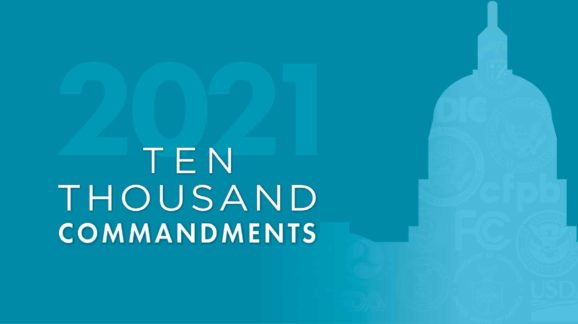New Ten Thousand Commandments report evaluates the sweeping hidden tax of regulation; Provides definitive assessment of Trump deregulatory legacy

The Competitive Enterprise Institute issued Ten Thousand Commandments 2021: An Annual Snapshot of the Federal Regulatory State today, a report by Vice President for Policy Wayne Crews evaluating the burden imposed by federal government regulations, appraising the Trump Administration’s deregulatory efforts, and analyzing trends in the numbers of rules and regulations issued by agencies.
The 2021 edition of Ten Thousand Commandments is the latest in an annual series that examines the scope of the federal regulatory state to help illustrate the need for measures like regulatory budgeting and ultimately congressional accountability.
“The Trump Era highlighted the limits of regulatory reform when done unilaterally, even by a committed Executive Branch, because the ability to constrain the administrative state is limited both by onerous procedures and the ability of a future president to unilaterally reverse a predecessor’s Executive Orders,” said Crews. “For the nation’s stability and economic health, the regulatory process should be as transparent as possible and subject to greater democratic accountability and constitutional norms. The only way to truly and permanently reform the administrative state is for Congress to reassert its authority to make law and stop outsourcing its Article I power to unelected bureaucrats.”
Key facts and points in the report:
- The “Unconstitutionality Index”—the ratio of rules issued by agencies relative to laws passed by Congress and signed by the president — underscores the rise of the administrative state over the Constitution. There were 19 rules for every law in 2020 (The average ratio for the previous decade was 28).
- The aggregate cost of federal regulation tops $1.9 TRILLION annually – and that is a conservative estimate based on publicly available data from government, academia, and industry and the inherent unknowability of such costs.
- The cost of federal regulation to each U.S. household exceeds $14,000 annually, on average. For perspective, that equals about 17 percent of the average pre-tax household budget and is the second-biggest budget item after housing.
- The $1.9 trillion regulatory burden is virtually equivalent to the $1.9 trillion COVID-19 American Rescue Plan Congress passed in March 2021. COVID stimulus cost taxpayers $1.9 trillion, but regulations impose a more hidden cost of ANOTHER $1.9 trillion – ouch!
- With Federal spending topping $6.5 TRILLION in 2020, including COVID-related spending and bailouts, the $1.9 trillion regulatory burden is equivalent to more than 33 percent of total federal spending. Ominously, the previous year estimated regulatory costs at 40 percent of total Federal spending, which was $4.447 trillion in 2019.
- The $1.9 trillion “hidden tax” of regulation rivals the $2.076 trillion in corporate and personal income taxes combined ($1.812 trillion in individual income tax revenues and $264 billion in corporate income tax revenues).
- The cost of regulation ($1.9 trillion) + the peak COVID federal outlays ($6.552 trillion in 2020) is equivalent to 40 percent of the economy. In other words, the cost of regulation combined with spending effectively negated 40 percent of what the US economy produced last year.
- The number of pages in the Federal Register in 2020 rose to 86,356 pages, which is the second highest count ever. However, Trump’s rollbacks of rules also necessarily added to rather than subtract from the total pages in the Register.
- The Trump Administration technically exceeded its “one-in, two-out” goals for adoption of significant regulatory action in each fiscal year. But the former administration’s own regulatory impulses, detailed in Ten Thousand Commandments, offset that agenda.
The report urges Congress to take responsibility by reviewing, debating, and voting on the costliest regulations. Specific reforms include: Executive Orders to permanently repeal recently waived regulations that were harming the coronavirus response, sunset dates for regulations, annual regulatory report cards with standardized, searchable information on existing and upcoming rules, and an independent regulatory reform commission to review existing regulations and recommend which ones to repeal.
- See the 2021 edition of 10KC at cei.org/10kc.
- See CEI President and CEO Kent Lassman’s video introduction of 10KC 2021: https://www.youtube.com/watch?v=rpcSnkGqovI